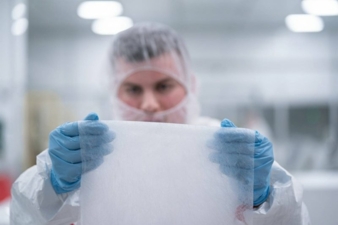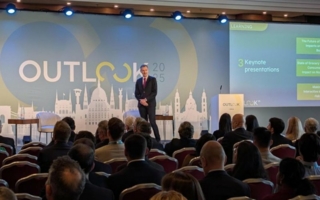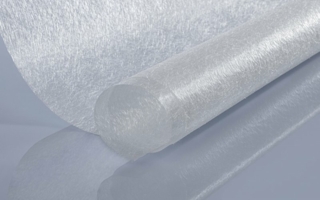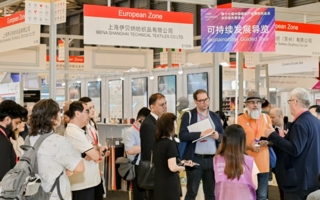23/12/2022 – Nonwovens — auf Deutsch lesen
ProQuIV optimizes the production of nonwoven masks
Fraunhofer researchers at ITWM have developed a technology which helps to save materials and energy when producing nonwovens.
The abbreviation “ProQuIV” stands for “Production and Quality Optimization of Nonwoven Infection Control Clothing”. The basic idea is that manufacturing process parameters are characterized with regard to their impact on the uniformity of the nonwoven, and this impact is then linked to properties of the end product; for example, a protective mask. This model chain links all relevant parameters to an image analysis and creates a digital twin of the production process. The digital twin enables real-time monitoring and automatic control of nonwoven manufacturing and thus makes it possible to harness potential for optimization.
“One of the key aims of our research project was to link central parameters such as filtration rate, flow resistance and cloudiness of a material with each other and to use this basis to generate a method which models all of the variables in the production process mathematically,” says Dr. Ralf Kirsch, who works in the Flow and Material Simulation department and heads up the Filtration and Separation team at Fraunhofer Institute for Industrial Mathematics ITWM. The digital twin monitors and controls the ongoing production process in real time. If the system deviates slightly from where it should be – for example, if the temperature is too high – the settings are corrected automatically within seconds.
Fast and efficient manufacturing
“This means that it is not necessary to interrupt production, take material samples and readjust the machines. Once the models have been calibrated, the manufacturer can be confident that the nonwoven coming off the belt complies with the specifications and quality standards,” explains Kirsch. ProQuIV makes production much more efficient – there is less material waste, and the energy consumption is also reduced. Another advantage is that it allows manufacturers to develop new nonwoven-based products quickly – all they have to do is change the target specifications in the modeling and adjust the parameters. This enables production companies to respond flexibly to customer requests or market trends.
This might sound logical but can be quite complex when it comes to development. The way that the values for filtration performance and flow resistance increase, for example, is not linear at all, and they are not proportional to the fiber volume ratio either. This means that doubling the filament density does not result in double the filtration performance and flow resistance – the relationship between the parameters is much more complex than that. “This is precisely why the mathematical modeling is so important. It helps us to understand the complex relationship between the individual process parameters,” says ITWM researcher Kirsch. The researchers are able to draw on their extensive expertise in simulation and modeling for this work.
More applications are possible
The next step for the Fraunhofer team is to reduce the breathing resistance of the nonwovens for the wearer without impairing the protective effect. This is made possible by electrically charging the fibers and employing a principle similar to that of a feather duster. The electric charge causes the textile fabric to attract the tiniest of particles which could otherwise slip through the pores. For this purpose, the strength of the electrostatic charge is integrated into the modeling as a parameter.
The Fraunhofer researchers’ plans for the application of this method extend far beyond masks and air filters. Their technology is generally applicable to the production of nonwovens — for example, it can also be used in materials for the filtration of liquids. Furthermore, ProQuIV methods can be used to optimize the manufacture of nonwovens used in sound-insulating applications.




